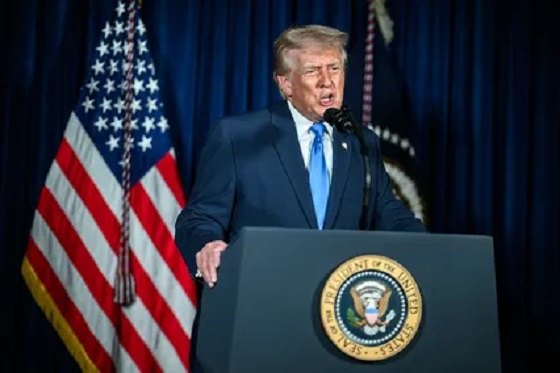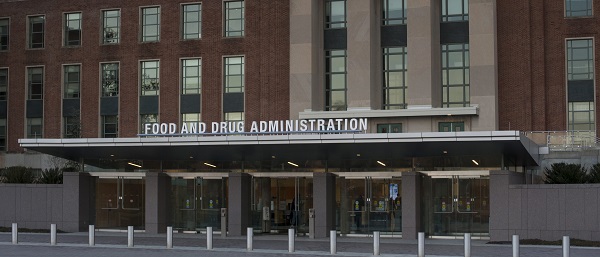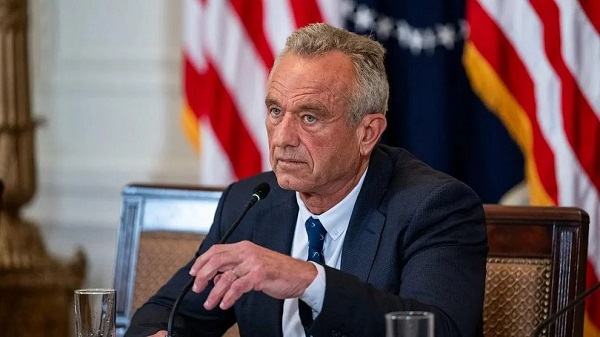Daily Caller
Harris Took The Reins On Solving A Key Region’s Migrant Crisis — Nearly 1.8 Million People Crossed Into US Anyway

 From the Daily Caller News Foundation
From the Daily Caller News Foundation
Over a million migrants hailing from Central America have crossed illegally into the U.S. since Vice President Kamala Harris was tapped to address the illegal immigration crisis stemming from that region.
Since the launch of her presidential campaign, Harris and her allies have vehemently pushed back on the narrative that she was appointed to serve as “border czar” for the White House, arguing that she was only given a limited role addressing the “root causes” of illegal migration stemming from Central America. However, roughly 1.7 million people from the Northern Triangle region, which includes El Salvador, Guatemala and Honduras, flooded into the U.S. after she was tasked with mitigating the crisis.
“It’s total chaos on the border, and has been for the last three and a half years,” retired Border Patrol Chief Rodney Scott said about the current border situation to the Daily Caller News Foundation. “America is put at risk for no good reason and they’re being sold a bill of goods that’s just not true.”
Border Patrol agents deployed along the southern border encountered a total of 1,739,795 migrants from El Salvador, Guatemala and Honduras attempting to cross illegally into the country between April 2021 — Harris’ first full month serving as “border czar” — and June 2024, according to a review of the latest available data by Customs and Border Protection (CBP).
“I’ve asked her, the VP, today — because she’s the most qualified person to do it — to lead our efforts with Mexico and the Northern Triangle and the countries that help — are going to need help in stemming the movement of so many folks, stemming the migration to our southern border,” Biden publicly declared on March 24, 2021.
The president added that there was nobody “better qualified” to handle the task and said she wouldn’t have to check in with him because she “knows what she’s doing.”
“But — so, Madam Vice President, thank you. I gave you a tough job, and you’re smiling, but there’s no one better capable of trying to organize this for us,” Biden continued.
Since that speech was given, 253,027 illegal migrants from El Salvador, 798,678 illegal migrants from Guatemala and 688,090 illegal migrants from Honduras have descended on the U.S.-Mexico border — totaling the more than 1.7 million encounters, according to CBP data. The numbers under Harris’ “border czar” tenure surpass the roughly 1,098,000 Border Patrol apprehensions of these three nationalities seen under the Trump administration from fiscal year 2017 to fiscal year 2020, according to past CBP data.
What further exacerbated the immigration crisis under the Biden-Harris administration was the influx of other foreign nationals who have used Central America as a way station en route to the U.S. border — most notably Venezuelans. While non-Central Americans did not technically fall under the vice president’s purview, the lack of border enforcement in the region has skyrocketed the U.S. asylum crisis.
Less than 50,000 Venezuelan nationals were encountered by Border Patrol agents in fiscal year 2021, according to CBP data. That number blew up to more than 187,000 in fiscal year 2022 and peaked at more than 200,600 in fiscal year 2023.
Venezuelans are far from the only ones crossing the Central American region in their journey to illegally enter the U.S. More than half a million U.S.-bound migrants crossed the Darien Gap — a dense jungle that spans across the border of Panama and Colombia — in 2023 alone, according to the Council on Foreign Relations
Illegal border crossings from other nationalities have also exploded under Harris’ “border czar” tenure.
There were less than 2,000 encounters with Chinese nationals at the southern border in fiscal year 2022, according to CBP Data. That figure exploded to over 24,000 in fiscal year 2023 and has already surpassed 33,000 this fiscal year, despite the year not yet over.
Similar spikes in illegal southern border crossings took place under the Biden-Harris administration by Indians, Turks, Nicaraguans, Russians and other nationalities.
Republicans have long hammered Harris for allegedly not taking the border crisis seriously, and recently released surveys indicate that most Americans believe her to be supportive of “open borders.”
For her part, Harris did visit Central America in June 2021 and warned would-be illegal migrants: “Do not come. Do not come.” She also visited the U.S.-Mexico border once in June 2021 after facing mounting pressure to do so.
Since Biden dropped out of the 2024 presidential contest and Harris became the presumptive Democratic presidential nominee, she has attempted to cast herself as a tough-on-crime prosecutor who would govern with border hawk tendencies. Her campaign has released two different advertisements claiming she would “fix” the border crisis and hire more Border Patrol agents.
Harris previously supported decriminalizing illegal border crossings, but the latest statements from her campaign suggest she has completely flipped on the position. It’s also not immediately clear if her running mate, Minnesota Gov. Tim Walz, remains a supporter of sanctuary city policies.
“The truth is, Vice President Kamala Harris has always been for open borders. She can’t run from that,” said Joey Chester, communications manager for the Federation for American Immigration Reform, in a statement to the DCNF.
Chester listed Harris’ past opposition for a border wall, rejection of more funding for Border Patrol agents and detention beds and past support for DACA beneficiaries to be compensated as congressional employees as reasons to be suspect of her current pivot to the right on border enforcement.
“These policies have proven disastrous and are deeply unpopular with the American people,” he added. “Words can’t change the fact that the current state of America’s borders, and the influx of illegal aliens in the United States today, is the doing of President Biden and Vice President Harris.”
The Harris campaign did not respond to a request for comment from the DCNF.
(Featured Image Media Credit: Flickr/Official White House Photo by Adam Schultz)
Daily Caller
Trump Reportedly Escalates Pressure On Venezuela With Another Oil Tanker Seizure


From the Daily Caller News Foundation
The U.S. intercepted and seized a vessel in international waters near Venezuela, marking the second such operation in recent weeks, multiple outlets reported Saturday.
The U.S. Coast Guard led the operation with assistance from other branches of the military, U.S. officials told CNN.
The interdiction follows on the heels of the Dec. 10 seizure of a sanctioned tanker off the Venezuelan coast. It also comes just days after President Donald Trump announced a sweeping blockade on all sanctioned oil tankers arriving to or leaving the South American nation, the ruling regime of which he designated a foreign terrorist organization.
Dear Readers:
As a nonprofit, we are dependent on the generosity of our readers.
Please consider making a small donation of any amount here.
Thank you!
“The illegitimate Maduro Regime is using Oil from these stolen Oil Fields to finance themselves, Drug Terrorism, Human Trafficking, Murder, and Kidnapping,” Trump posted Tuesday on Truth Social. “I am ordering A TOTAL AND COMPLETE BLOCKADE OF ALL SANCTIONED OIL TANKERS going into, and out of, Venezuela.”
When asked following the first seizure what the U.S. would do with the confiscated oil, Trump said, “Well, we keep it, I guess.”
The operations come amid months of escalating U.S. pressure on Venezuela.
American armed forces have steadily increased their presence and operations in the southern Caribbean off Venezuela’s coast, including numerous strikes on drug smuggling vessels. The buildup has fueled speculation about a potential full-scale confrontation with Maduro or even a material push for regime change.
Trump reportedly offered Maduro a deal in late November to vacate power in exchange for safe passage for him and his family. The U.S. also placed a $50 million bounty on Maduro in August, the largest sum ever offered for a sitting head of state.
In announcing the blockade Tuesday, Trump warned the “illegitimate Maduro Regime” that the “Armada” surrounding the country “will only get bigger, and the shock to them will be like nothing they have ever seen before.” He also demanded that Maduro “return to the United States of America all of the oil, land, and other assets that they previously stole from us.”
Despite the growing pressure, Maduro dispatched two non-sanctioned vessels Thursday carrying oil to China, Reuters reported.
The Coast Guard referred questions on the operation to the White House, which did not immediately respond to the Daily Caller News Foundation’s request for comment.
Daily Caller
Ex-FDA Commissioners Against Higher Vaccine Standards Took $6 Million From COVID Vaccine Makers


From the Daily Caller News Foundation
By Emily Kopp
The FDA old guard criticized the new leadership in a Dec. 3 New England Journal of Medicine (NEJM) letter over a higher regulatory bar for vaccines, namely the expectation that most new vaccine approvals will require randomized clinical trials, arguing it could hamper the market.
“Insisting on long, expensive outcomes studies for every updated formulation would delay the arrival of better-matched vaccines when new outbreaks emerge or when additional groups of patients could benefit,” the former commissioners wrote. “Abandoning the existing methods won’t ‘elevate vaccine science’ … It will subject vaccines to a substantially higher and more subjective approval bar.”
But while the former commissioners disclosed their conflicts of interest to the medical journal — per standard practice in scientific publishing — reporters didn’t relay them to the broader public in reports in the Washington Post, STAT News and CNN.
The headlines about a bipartisan rebuke from former occupants of FDA’s highest office give the impression that the Trump administration is contravening established science, but closer inspection reveals a revolving door between pharmaceutical corporations and the agencies overseeing them.
Three of the signatories have received payments totaling $6 million from manufacturers or former manufacturers of COVID vaccines.
Scott Gottlieb has received $2.1 million in cash and stock from his position on the Pfizer board of directors, where he has advised on ethics and regulatory compliance since 2019, according to company filings to the Securities and Exchange Commission. Stephen Ostroff has received $752,310 from Pfizer in consulting fees since 2020, according to OpenPayments.
Mark McClellan has received $3.3 million from Johnson & Johnson as a member of the board of directors since 2013, SEC filings also show. McClellan also consults for the new pharmaceutical arm of the alternative investment management company Blackstone, which invested $750 million in Moderna in April 2025.
Gottlieb and McClellan did not respond to requests for comment. Ostroff could not be reached for comment.
FDA Center for Biologics Evaluation and Research Director Vinay Prasad outlined the higher standards and shared the results of an internal analysis validating 10 reports of children’s deaths following the COVID-19 vaccine in a Nov. 28 memo to staff. He called for introspection and reform at the agency.
The NEJM letter criticizes Prasad for cracking down on a practice called “immunobridging” that infers vaccine efficacy from laboratory tests rather than assessing it through real-world reductions in disease or death. The FDA under the Biden administration expanded COVID vaccines to children using this “immunobridging” technique, extrapolating vaccine efficacy from adults to children based on antibody levels.
Norman Sharpless — who in addition to previously serving as acting FDA commissioner also served as the head of the National Institutes of Health’s National Cancer Institute — consults for Tempus, a company that collaborates with COVID vaccine maker BioNTech. He has helped steer $70 million in investments in biotech through a venture capital firm he founded in November 2024. Sharpless also disclosed $26,180 in payments in 2024 from Chugai Pharmaceutical, a Japanese pharmaceutical company that markets mRNA technology among other drugs, on OpenPayments.
“I was grateful for the opportunity to serve as NCI Director and Acting FDA Commissioner in the first Trump Administration, and strongly support many of the things President Trump is trying to do in the current Administration,” Sharpless said in an email.
Margaret Hamburg, another former FDA commissioner and signatory of the NEJM letter, has since 2020 earned $2.8 million as a member of the board of Alnylam Pharmaceuticals, which markets RNA interference (RNAi) technology.
Hamburg did not respond to a message on LinkedIn.
Most signatories disclosed income from biotech companies testing experimental cancer treatments. These products could face tighter scrutiny under Prasad, a hematologist-oncologist long wary of rubberstamping pricey oncology drugs — which Prasad points out often cause some toxicity — without plausible evidence of an improvement in quality of life or survival.
The former FDA commissioners disclosed ties to Sermonix Pharmaceuticals Inc.; OncoNano Medicine; incyclix; Nucleus Radiopharma; and N-Power, a contractor that runs oncology clinical trials.
Andrew von Eschenbach, who like Sharpless formerly served both as FDA commissioner and the head of the National Cancer Institute, disclosed stock in HistoSonics, a company with investments from Bezos Expeditions and Thiel Bio seeking FDA approval for ultrasound technology targeted at tumors.
Some FDA commissioners who signed onto the letter opposing changes to vaccine approvals have ties to biotechnology investment firms, namely McClellan, who consults Arsenal Capital; Janet Woodcock, who consults RA Capital Management; and Robert Califf, who owns stock in Population Health Partners.
Califf did not respond to an email requesting comment. Woodcock did not respond to requests for comment sent to two medical research advocacy groups with Woodcock on the board. Eschenbach did not respond to a LinkedIn message.
The two signatories without pharmaceutical ties may find their judgement challenged by the FDA investigation into COVID-19 vaccine deaths, having either implemented or formally defended the Biden administration’s headlong expansion of vaccines and boosters to healthy adults and children.
David Kessler executed Biden’s vaccination policy as chief science officer at the Department of Health and Human Services, helping to secure deals for shots with Pfizer and Moderna.
Meanwhile Jane Henney chaired a National Academies of Sciences, Engineering, and Medicine report published in October 2025 that praised the performance of FDA and Centers for Disease Control and Prevention (CDC) vaccine surveillance during the pandemic — underwritten with CDC funding.
That assessment clashes with that of a Senate report, citing internal documents from FDA, finding that CDC never updated its vaccine surveillance tool “V-Safe” to include cardiac symptoms, despite naming myocarditis as a potential adverse event by October 2020, and that top officials in the Biden administration delayed warning pediatricians and other providers about the risk of myocarditis after their approval in some children in May 2021, months after Israeli health officials first detected it in February 2021. The Senate investigation named Woodcock, a signatory of the NEJM letter, as one of the FDA officials who slow-walked the warning.
-

 Uncategorized1 day ago
Uncategorized1 day agoMortgaging Canada’s energy future — the hidden costs of the Carney-Smith pipeline deal
-

 Business2 days ago
Business2 days agoThere’s No Bias at CBC News, You Say? Well, OK…
-

 International1 day ago
International1 day agoAustralian PM booed at Bondi vigil as crowd screams “shame!”
-

 Opinion2 days ago
Opinion2 days agoReligion on trial: what could happen if Canada passes its new hate speech legislation
-

 Automotive23 hours ago
Automotive23 hours agoCanada’s EV gamble is starting to backfire
-

 Agriculture20 hours ago
Agriculture20 hours agoEnd Supply Management—For the Sake of Canadian Consumers
-

 Alberta19 hours ago
Alberta19 hours agoAlberta Next Panel calls to reform how Canada works
-

 Environment17 hours ago
Environment17 hours agoCanada’s river water quality strong overall although some localized issues persist









